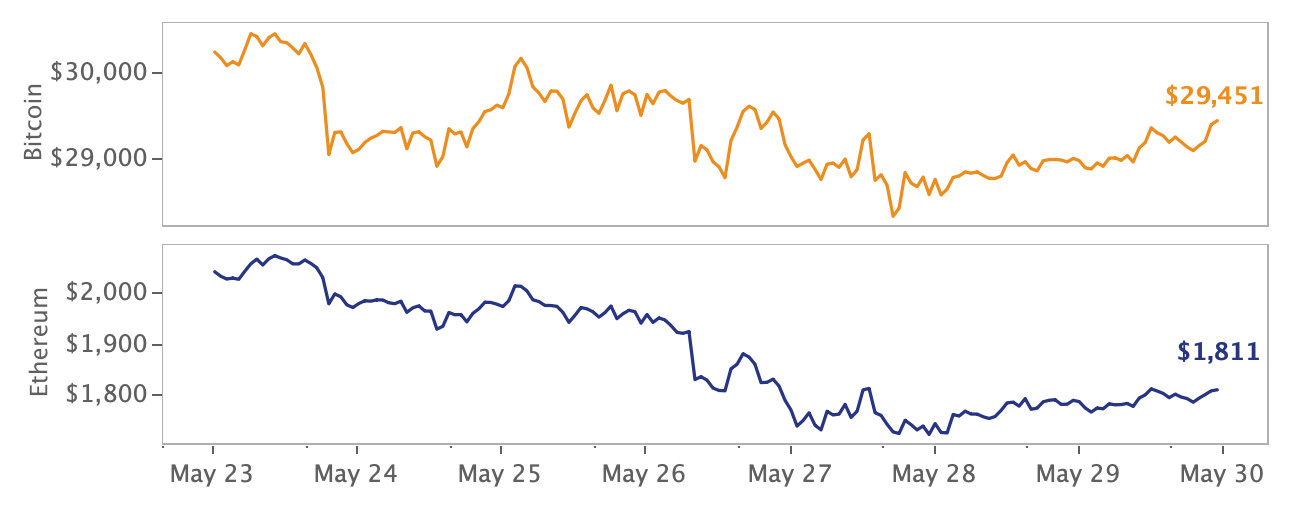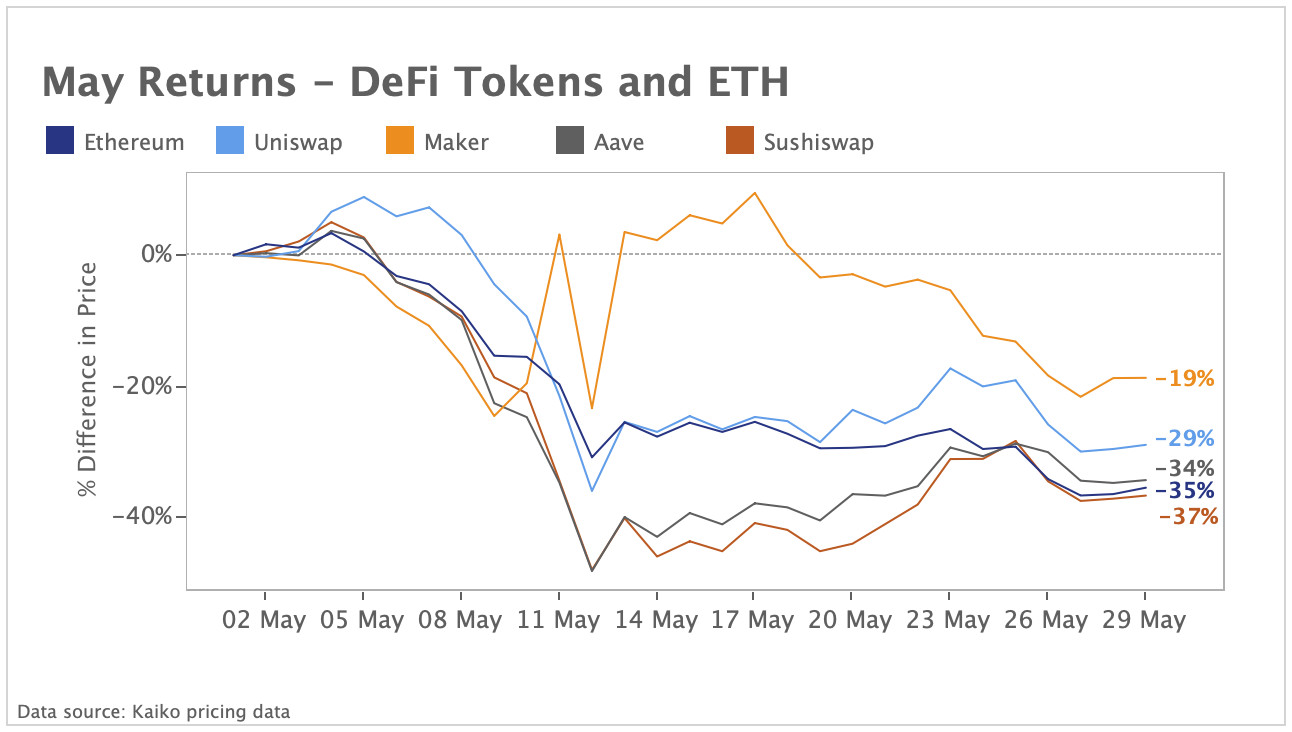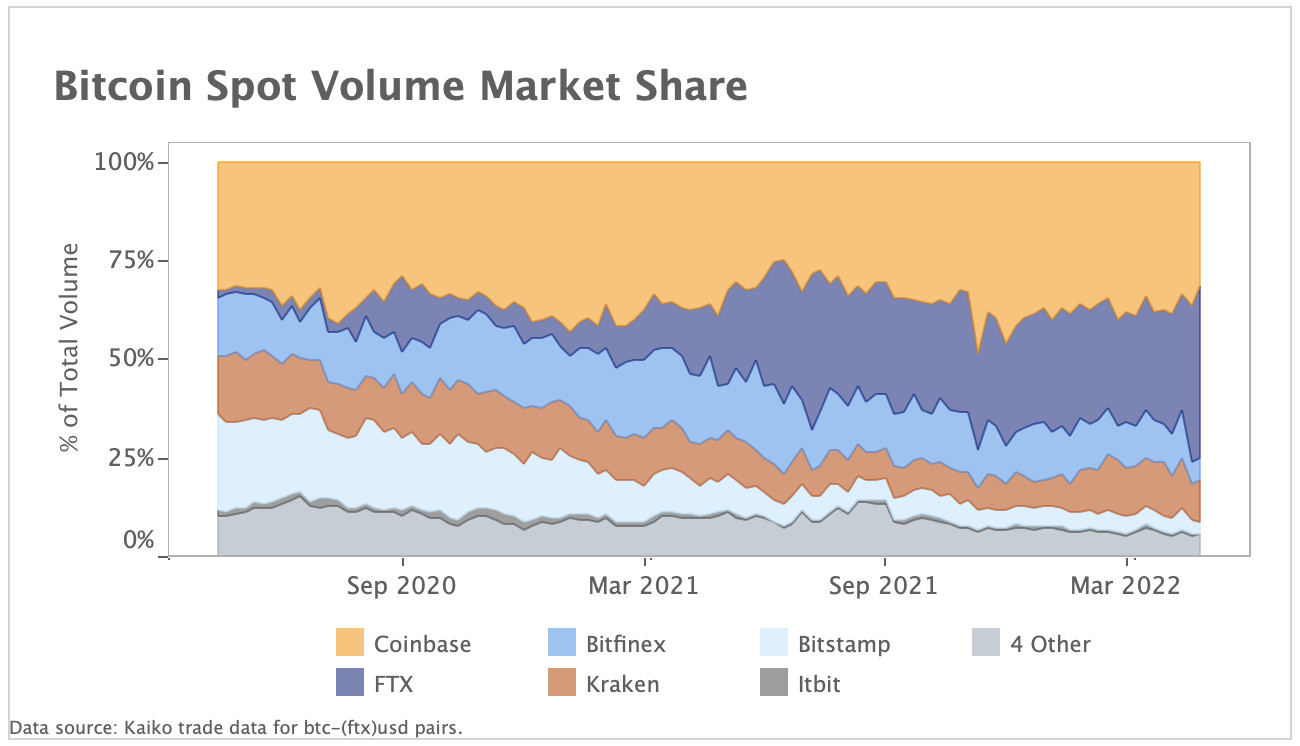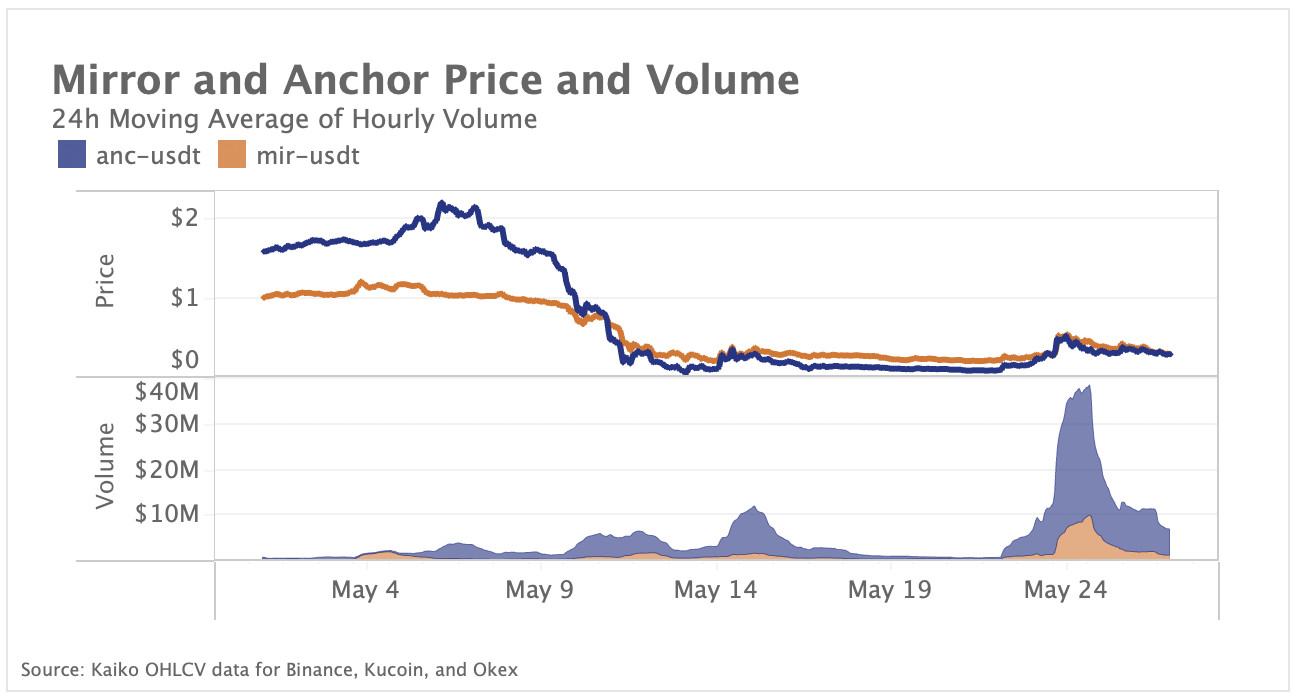A summarizing review of what has been happening at the crypto markets of the past week. A look at trending sectors, liquidity, volatility, spreads and more. The weekly report in cooperation with market data provider Kaiko.
The last 7 days in cryptocurrency markets:
- Price Movements: Despite recovering global risk sentiment, BTC and ETH ended the week down 2.6% and 11% respectively.
- Order Book Liquidity: FTX trade volumes for Bitcoin surpassed Coinbase for the first time ever in May.
- Derivatives: Open interest denominated in ETH increased as price plummeted.
- Macro Trends: Bitcoin's correlation with U.S. equities falls from record highs.
Crypto markets in the red despite risk sentiment recovery

Global risk sentiment recovered last week on the back of less hawkish than expected minutes from the latest Fed meeting and slowing U.S. inflation data. However, the risk-on mood failed to spill into crypto. Both Bitcoin (BTC) and Ethereum (ETH) ended the week in the red, with Ethereum underperforming significantly amid lower NFT and DeFi demand and a network "reorg" issue which saw transactions being processed on two different versions of the chain. The issue doesn't appear to be a long-term worry for the upcoming proof of stake merge, as it stemmed from certain validators running outdated software.
Despite the continued market bearishness, venture capital firm Andreessen Horowitz announced the launch of the largest crypto fund ever and JP Morgan announced a trial using blockchain for collateral settlement. Terra’s plan to split the blockchain was also approved, abandoning the collapsed UST stablecoin.
DeFi tokens sink in aftermath of Terra collapse
DeFi tokens have felt the full force of the recent bear market with many tokens down over 40% just for the month of May. Many DeFi tokens moved in line with Ethereum’s downward price action of about 35% as investors looked to de-risk after the Terra/Luna collapse. Prices have been strongly correlated to the sharp decrease in Total Value Locked on DeFi protocols. Uniswap's UNI token slightly outperformed Ethereum as the decentralised exchange (DEX) reached $1 trillion in total lifetime volume last week. The most noticeable outperformer this month was Maker, which is down only 19% so far for the month of May. Maker is the governance token for the ecosystem that mints the decentralized stablecoin DAI. DAI is overcollaterized and is therefore being seen by investors as a healthy, decentralised alternative to the failed UST experiment.
FTX volumes surpasses Coinbase for first time
Global crypto exchange FTX saw a surge in market share of volume in May, exceeding Coinbase for the first time ever. Above, we chart the market share of the most liquid Bitcoin pairs on 10 major exchanges. We observe that FTX has gained significant traction over the past year with its market share surging from 5% to 44% over the past 18 months. The trend accelerated in May following Terra ecosystem's collapse and sell-off. Coinbase managed to keep its market share relatively stable at around 30%. However, other smaller exchanges such as Bitfinex registered significant declines in trade volumes. The trend suggests that the market is consolidating amid prolonged bearish sentiment with smaller players having a harder time keeping up with the competition.
Terra alt volumes spike as Luna 2.0 proposal passes
Two of the oldest and most established protocols on the Terra blockchain, Anchor and Mirror, sold off quickly as Luna and UST began their collapse on May 8. Trade volumes picked up slightly on May 14 as community discussions began regarding next steps for Terra. Last week, volumes spiked to their highest level this year and prices recovered slightly as it became clear on May 24 that a governance proposal to create a new chain without an algorithmic stablecoin would pass. Terra Luna has since been renamed Terra Luna Classic and a new chain went online on May 27. Anchor and Mirror have not announced their next steps, but given their close affiliation with Terraform Labs it is likely that they will move to the new chain.
Open interest denominated in ETH increasing as funding rates dip negative
As Ethereum's price took a nosedive last week, we observed a noticeable increase in open interest denominated in ETH that we did not observe for BTC. Denominating open interest in the native token can be a useful measure in gauging derivatives market activity without reflecting price movements. A build up in open interest means that investors were entering more long or short positions.
In order to get a better idea of the directionality of these positions we can look at funding rates which will be negative if these were mostly short driven, or positive if more investors were entering into long futures positions. We observed negative funding rates that coincided with the increase in open interest denominated in ETH which would indicate that the majority of the buildup was likely short driven. Funding rates bounced back to neutral or slightly positive territory later in the week however, as ETH price action somewhat stabilized.
Bitcoin's correlation with U.S. equities weakens
Bitcoin decoupled from U.S. equities last week, extending its losing streak to a record 8 weeks. Above we chart the 30-day rolling correlation of Bitcoin, the S&P 500 and the Nasdaq 100. Despite remaining high, at around 0.7, it has declined to its lowest level in more than a month.
The market focus has shifted from inflation to growth worries over the past weeks as the Fed’s hawkish policy, dragging war in Ukraine and covid-related restrictions in China boosted recession fears. However, less hawkish than expected minutes from the May 3-4 Fed FOMC meeting alongside slowing inflation and rising consumer spending supported a relief rally in risk assets. The benchmark S&P 500 and the tech-focused Nasdaq 100 rose by 6.6% and 7.1% respectively, snapping a 7-week losing streak. The risk-on mood failed to spill into crypto which could be the result of a more cautious approach to the space following Terra’s collapse.
Crypto mining companies underperform broader markets
With Bitcoin prices tumbling and mining difficulty on the rise, the profitability of mining companies has taken a hit. Above we chart the market performance of the Valkyrie Bitcoin Miners ETF, which offers exposure to public bitcoin mining companies, alongside Bitcoin’s price and network hash rate since the start of February. The hash rate, which is an indicator of how much computing power is being used by the network to process transactions, adjusts every two weeks and is directly correlated with the mining difficulty. A rising hash rate suggests higher mining costs, which can directly impact miner profits.
We observe that mining companies have underperformed the broad crypto market by a large margin, falling by over 50% since the start of February versus a 30% drop in Bitcoin spot prices. Despite large public bitcoin mining companies still mining profitably, profit margins are thinning, putting pressure on over-leveraged companies with high operating costs (i.e. infrastructure and machines).










